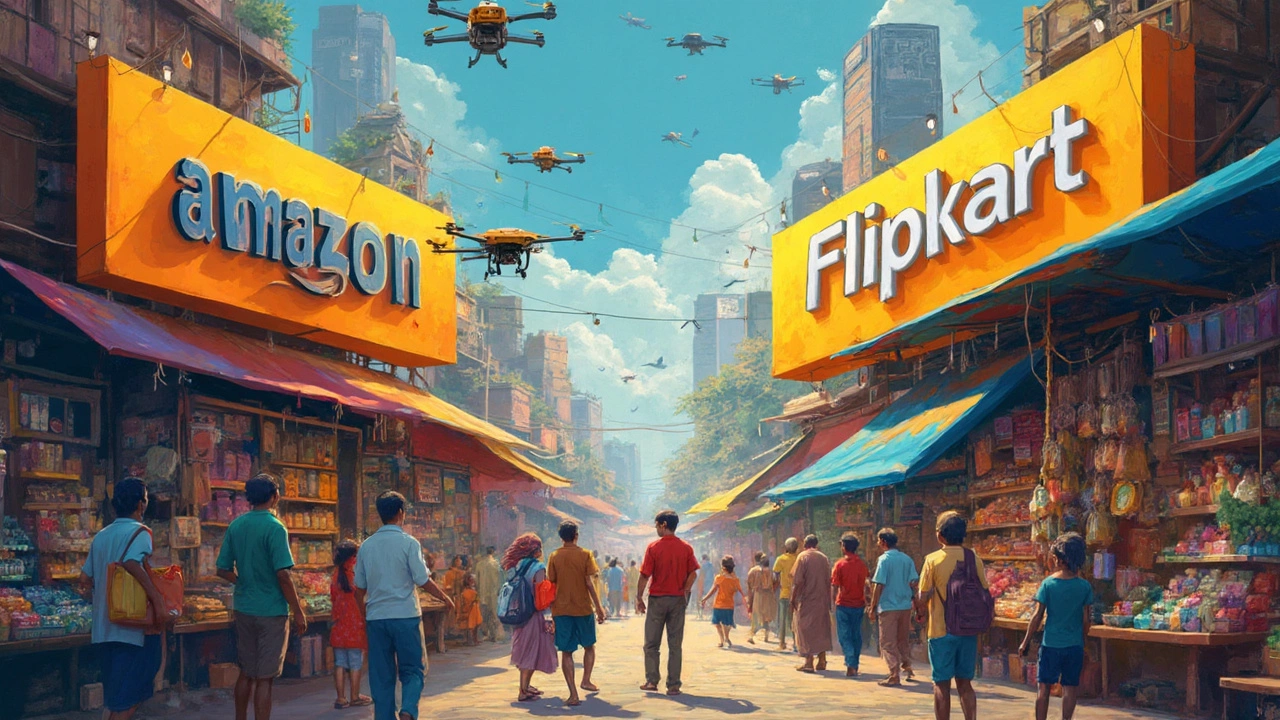In the hustle and bustle of India's online shopping world, Amazon India and Flipkart are like the heavyweight champs constantly jostling for the top spot. These two have been sparring it out, each swinging with their unique set of advantages to woo customers. So, ever wondered which one might be the bigger gun in India? Let's break it down, shall we?
The Indian e-commerce scene is no joke. A market that's been rapidly expanding means both Amazon and Flipkart have had to bring their A-game. Amazon, entering the Indian market later in 2013, came with its global experience. But Flipkart wasn't just going to roll over. Having started in 2007, Flipkart was already a household name for many Indians by the time Amazon showed up.
The Market Battle
The competition between Amazon India and Flipkart isn't just about who's got the flashiest ads or the most gadgets on sale. It's about who can capture the hearts—and wallets—of Indian consumers in a colossal e-commerce landscape.
You probably know that Amazon is a global behemoth, and in India, it's leveraged that to its advantage by offering a wide variety of products and reliable delivery service. But Flipkart, with its deep understanding of local tastes, smart partnerships, and exclusive product launches, isn't trailing far behind. It's often neck-and-neck.
Both companies have made massive investments to strengthen their positions. To give you a clearer picture, Amazon has poured in more than $6 billion into its Indian operations since its launch, focusing on logistics, customer service, and technology. Flipkart, backed by Walmart's $16 billion acquisition in 2018, uses this support to enhance its warehousing and supply chain tech.
As the narrative unfolded, each player sought diverse strategies to expand their influence. Amazon India introduced the Prime membership, which has grown popular with urban users for its quick deliveries and streaming services. On the flip side, Flipkart campaigns like 'The Big Billion Days' have become shopping festivals, attracting millions of buyers aiming for that killer deal.
Still, one of the vital battlegrounds is the smartphone segment. Both giants have vigorously expanded their mobile shopping options, with Flipkart even launching its own phones under the Billion brand briefly.
Here’s a quick look at their revenues over the past few years:
| Year | Amazon India Revenue (in billion USD) | Flipkart Revenue (in billion USD) |
|---|---|---|
| 2021 | 4.5 | 3.8 |
| 2022 | 5.7 | 4.5 |
| 2023 | 6.9 | 5.7 |
As you can see, the numbers are close, reflecting a competitive market scenario.
Deciding who's leading isn't straightforward. It depends on what metrics you value more—be it revenue, market share, or user loyalty. One thing's for sure: this rivalry is far from over, and it's an exciting time to watch how the scene will evolve.
Unique Selling Points
When it comes to standing out, both Amazon India and Flipkart have their unique flair. Amazon is like that friend with all the right connections. Thanks to its global presence, Amazon brings a vast product range to the table, allowing customers to shop across categories like electronics, fashion, and groceries. Plus, its Prime membership perks, like fast shipping and access to Amazon Prime Video, make quite the compelling package.
Flipkart, on the other hand, feels more like that local buddy who knows all the right spots around town. Being homegrown, they've tuned in to what Indian shoppers love, from festive sales to cash on delivery options which still remain popular in several regions. Its genius move? Collaborating with brands directly to offer exclusive products, often at cheaper rates.
Amazon definitely wows with its customer service, offering hassle-free returns and committed delivery timelines that customers generally trust. Flipkart, keeping it real and relatable, offers more customer-friendly payment options like buy now, pay later, and no-cost EMI plans, really hitting the sweet spot for value-conscious Indian shoppers.
Both platforms are racing to outdo while learning from each other's playbooks. While Amazon might have a technological edge by borrowing from its international resources, Flipkart uses its deep understanding of Indian markets to taper its sales strategy. Not a clear winner in sight, these two are hoping their unique selling propositions keep them ahead in the game.

Technological Innovations
When it comes to tech, both Amazon India and Flipkart have pulled out all the stops to attract and keep customers. They’re not just about good prices and fast delivery anymore; technology is at the heart of their operations.
Amazon India has integrated its global tech prowess into the local market. They boast powerful algorithms that personalize shopping experiences, predicting what you might want before you even know it. It’s kind of like how your cat can sniff out Whiskers treats from a mile away. Plus, Amazon has been dabbling with drone delivery, which might sound like something out of a sci-fi movie, but it’s all about speeding up delivery times.
On the flip side, Flipkart isn't lagging. They’ve come up with some pretty nifty tech solutions themselves. Take their AI-powered assistant, for example, which helps customers find products faster and answers queries in real-time. They’ve focused on making the shopping experience seamless and have made big strides in using machine learning to predict shopping patterns.
Both platforms have been experimenting with AR (augmented reality) features, allowing customers to virtually try products before they buy. Imagine trying on clothes or checking how furniture fits in your room without leaving the couch!
Let’s toss in a fun fact: Flipkart's app improvements have helped them significantly reduce load times, which means more customers hanging around and adding items to their carts. Faster apps = happier shoppers.
With both companies investing heavily in tech, they’re not just relying on fancy gadgets but are focused on solving real problems for their users. Long story short, whether you’re loyal to Amazon or a Flipkart fan, you're benefiting from some serious technological wizardry behind the scenes.
Customer Experience
Ah, customer experience, the secret sauce that keeps folks coming back. Both Amazon India and Flipkart know this game well. Let's dive into what makes each platform tick in this department.
Starting with Amazon India, they've built a reputation for being super-responsive. Their customer service is known for being top-notch, with easy returns and refunds that make shopping feel less like a gamble. Plus, with features like one-day and two-day delivery options, they cater pretty well to the impatient shopper in all of us. Nothing beats the thrill of hitting 'order' and hearing your doorbell ring so soon after!
On the other hand, Flipkart has its own unique flavor when it comes to catering to customers. They're known for their big sales events, like the Big Billion Days, which gets everyone excited. They’ve tailored their platform to feel more localized, capturing the essence of what Indian consumers look for. Plus, their phone support in regional languages makes it feel like home for many.
When it comes to the nitty-gritty, things like app interface, both Amazon and Flipkart have user-friendly designs. Flipkart has a slick interface adapted well for Indian markets, while Amazon sticks to its classic, organized layout. Now if you're wondering which app to choose, it might just come down to your personal shopping style.
Both giants have invested heavily in delivery networks across the country, making sure you can get what you want almost anywhere. So, whether you’re nestled in a bustling city or a quiet town, you’ve got options.
To wrap it up, Amazon India and Flipkart have distinct strengths in how they handle customer experience. Your choice really might boil down to what feels like a better fit for your vibe. Either way, you’re in for a pretty smooth ride!

The Verdict
So, when it comes to the battle between Amazon India and Flipkart, who takes the crown? Well, it’s not a cut-and-dried answer. Both platforms have carved out their niches and possess unique strengths. But let's take a closer look at how they stack up.
In terms of market share, Amazon India and Flipkart are always neck and neck. As of 2024, both held nearly half of the online retail market, with Amazon slightly edging forward, thanks to its global reach and deep pockets. Strategically, Amazon has been pumping resources into expanding its logistics network and technology hubs across India, which boosts its efficiency and customer satisfaction.
Flipkart, on the other hand, keeps its stronghold with a deep understanding of the local market. Its acquisition by Walmart in 2018 gave it a financial muscle boost, and since then, Flipkart has been heavily investing in Indian sellers, exclusive brand partnerships, and tailored shopping experiences that resonate with local tastes.
When it comes to customer experience, both giants offer competitive pricing, a wide range of products, and fast delivery options. However, Flipkart sometimes gets the upper hand with its more localized offers and services during key sales events like the Big Billion Days.
Ultimately, it all boils down to what you're looking for. If you’re after a wide variety of choices and robust international support, Amazon India might be your go-to. But if you lean toward more personalized and local deals, Flipkart could be more up your alley. It's this fierce competition that keeps driving both players to innovate, which, at the end of the day, benefits you, the shopper.

